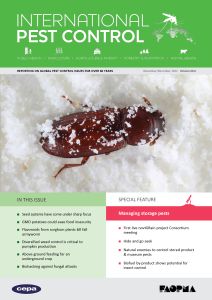Eco Bed Bug Exterminators Dc for Dummies
Eco Bed Bug Exterminators Dc for Dummies
Blog Article
How Eco Bed Bug Exterminators Dc can Save You Time, Stress, and Money.
Table of ContentsThe smart Trick of Eco Bed Bug Exterminators Dc That Nobody is Talking AboutWhat Does Eco Bed Bug Exterminators Dc Mean?What Does Eco Bed Bug Exterminators Dc Do?All About Eco Bed Bug Exterminators DcThe Single Strategy To Use For Eco Bed Bug Exterminators Dc
Because pesticides are hazardous, they are also possibly hazardous to people, pets, other organisms, and the environment. People that use chemicals or consistently come in call with them must comprehend the family member poisoning, potential wellness effects, and preventative measures to minimize exposure to the items they make use of. Hazard, or threat, of utilizing pesticides is the potential for injury, or the degree of risk entailed in utilizing a chemical under a given set of problems.
Applicators can decrease or nearly eliminate exposure-- and hence minimize risk-- by complying with the label instructions, utilizing personal safety apparel and devices (PPE), and managing the pesticide appropriately. More than 95 percent of all chemical direct exposures come from dermal exposure, largely to the hands and forearms. By using a pair of unlined, chemical-resistant handwear covers, this kind of direct exposure can be virtually removed.
The hazardous impacts that occur from a solitary direct exposure by any kind of route of entry are labelled "acute results." The four courses of direct exposure are dermal (skin), breathing (lungs), oral (mouth), and the eyes. Severe poisoning is established by taking a look at the facial poisoning, breathing poisoning, and oral poisoning of examination animals.
4 Easy Facts About Eco Bed Bug Exterminators Dc Shown
Intense poisoning is determined as the quantity or concentration of a toxicant-- the a.i.-- called for to eliminate half of the animals in an examination populace. This procedure is normally expressed as the LD50 (lethal dose 50) or the LC50 (deadly concentration 50). Furthermore, the LD50 and LC50 values are based upon a single dosage and are recorded in milligrams of pesticide per kilo of body weight (mg/kg) of the examination animal or in parts per million (ppm).
The lower the LD50 or LC50 worth of a chemical product, the greater its toxicity to human beings and animals. Chemicals with a high LD50 are the least toxic to human beings if used according to the directions on the product label. The persistent toxicity of a pesticide is identified by subjecting guinea pig to lasting exposure to the energetic ingredient.
The persistent poisoning of a chemical is much more challenging than intense poisoning to figure out with research laboratory evaluation. Products are categorized on the basis of their family member severe toxicity (their LD50 or LC50 values). Chemicals that are classified as very harmful (Poisoning Category I) on the basis of either oral, dermal, or breathing toxicity need to have the signal words DANGER and poisonous substance printed in red with a head and crossbones symbol plainly presented on the front panel of the package label.
The intense (solitary dose) dental LD50 for chemical products in this team varies from a trace total up to 50 mg/kg. For instance, exposure of a few declines of a product taken orally might be fatal to a 150-pound person. Some chemical items have just the signal word risk, which informs you nothing about the acute poisoning, simply that the product can trigger severe eye damage or severe skin irritability
3 Easy Facts About Eco Bed Bug Exterminators Dc Described
In this classification, the intense dental LD50 arrays from 50 to 500 mg/kg. A tsp to an ounce of this product can be fatal to a 150-pound individual (bed bug treatment). Pesticide products identified as either slightly hazardous or reasonably nontoxic (Toxicity Groups III and IV) are called for to have the signal word CAUTION on the chemical tag

All pesticide toxicity values, including the Consisting of, can be found on the product's Material Safety Data Security InformationMSDS). Pesticide tags and MSDS can be obtained from sellers or produces - https://www.intensedebate.com/profiles/ecobedbug3xt. The signs of pesticide poisoning can range from a mild skin irritability to coma or even fatality.
Individuals likewise differ in their sensitivity to different degrees of these chemicals. Some people may show no reaction to a direct exposure that might cause serious disease in others (exterminator DC). As a result of possible wellness concerns, pesticide individuals and trainers must acknowledge the usual symptoms and signs of pesticide poisoning. The effects, or symptoms, of chemical poisoning can be generally specified as either topical or systemic.
The Ultimate Guide To Eco Bed Bug Exterminators Dc
Dermatitis, or swelling of the skin, is approved as the most generally reported topical result linked with chemical direct exposure. Some individuals often tend to cough, wheeze, or sneeze when subjected to pesticide sprays.
This signs and symptom typically subsides within a couple of minutes after a person recommended you read is eliminated from the exposure to the toxic irritant. A reaction to a pesticide product that creates someone not only to sneeze and cough yet likewise to develop serious acute breathing signs and symptoms is a lot more most likely to be a real hypersensitivity or sensitive reaction.
Systemic results are rather different from topical results. They often occur away from the initial factor of contact as an outcome of the pesticide being taken in right into and dispersed throughout the body.
Report this page